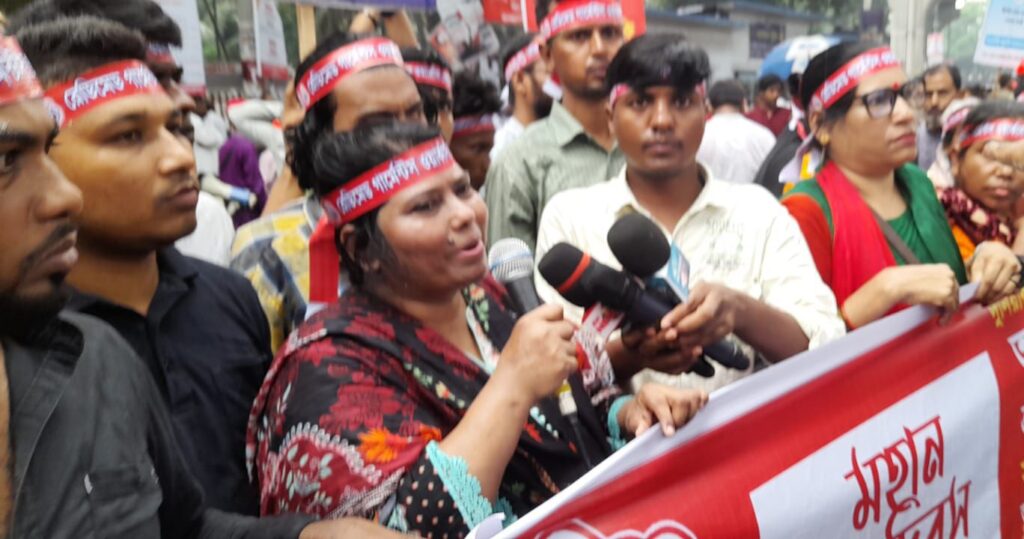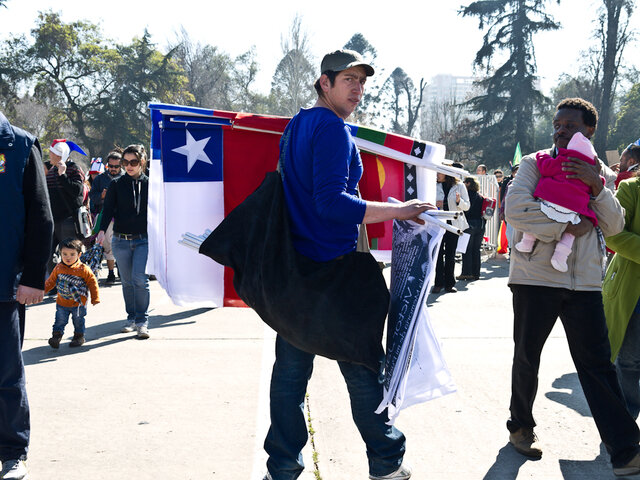
[More than a year has passed since the fall of Sheikh Hasina’s government in Bangladesh. While the pro-democracy movement was projected as being led primarily by students and youth, tens of thousands of ordinary working people also joined the struggle. Their voices, however, have remained largely unheard. How are they faring today?
At the heart of Bangladesh’s economy lies the ready-made garment (RMG) industry—the country’s single largest source of export earnings and a sector overwhelmingly powered by women. Bangladesh is now the world’s second-largest exporter of garments after China. T-shirts, trousers, sweaters, and jackets form the bulk of its exports, destined mainly for markets in the United States, the European Union (particularly Germany, the UK, and Spain), and Canada. According to 2024 figures, the garment sector accounts for nearly 84 percent of Bangladesh’s total export revenue.
The industry employs around 4 million workers, more than 80 percent of them women. To understand their situation, Alternative Viewpoint spoke with Lovely Yesmin, president of the Ready-Made Garments Workers Federation. Yesmin herself began working in the factories at the age of twelve, as a child labourer. Drawing on her own experience and her union work, she sheds light on the precarious realities faced by workers, the ongoing crises in the industry, and the uncertain future of labor struggles in Bangladesh’s garment sector. – ed.]
Tell us about the condition of garment workers in Bangladesh.
Lovely Yesmin – Currently, women who work in the garment industry in Bangladesh face a variety of challenges. While there has been some improvement, many challenges remain. On the positive side, these workers are more aware than before, their technical skills are improving, and many now have a say in household economic decisions. However, the reality is that in many factories, working conditions are still far from standard; safety measures, healthcare, and maternity benefits are largely inadequate. An even greater challenge is job security—due to a decline in exports, the risk of layoffs has increased. The workload is heavy while wages remain relatively low. Furthermore, among those who have lost their jobs, women workers constitute the majority, and many, out of sheer desperation, are now working in subcontracted factories for half the usual pay. Even under normal conditions, their wages were insufficient, and now they must survive on much less than before. You can imagine what this situation means for their quality of life. The market prices of essentials, particularly fish and meat, are extremely high. Living solely on eggs, lentils, and leafy greens, while producing high-quality garments for the dollar-dominated international market, is hardly sustainable for the human body—we all understand these facts well enough.
Whatever the circumstances, and however one might describe them, I must emphasise, as a trade unionist, that the condition of women workers in the garment sector has consistently been poor. Allow me to provide some context. During the 1980s and 1990s, a significant number of women from impoverished peasant families—families devastated by river erosion, landlessness, and the hardships of day labour—migrated from rural areas to Dhaka in search of employment in garment factories. Most of these women were aged between 15 and 20, although there were also divorced and widowed individuals among them. Furthermore, women from urban backgrounds—both married and unmarried—similarly sought work in garment factories. The majority of these workers had received little education, and many were entirely illiterate. These were the women who toiled in the industry, day in and day out, year after year. Additionally, there was a considerable presence of child workers, many of whom were under the age of fifteen.
Women workers frequently toiled from early morning until 10 or 12 at night, and sometimes even overnight. Their wages were meagre: helpers received only 300 to 500 taka per month (1 USD is equivalent to 121.50 taka), while machine operators earned between 1,000 and 1,500 taka.
There was no concept of benefits beyond daily attendance pay. Workers received no appointment letters or ID cards, and arbitrary dismissals were commonplace. Mid-level management often abused workers both verbally and physically. Employers routinely cut wages without compensation, and they stole or withheld overtime pay. Furthermore, they failed to provide even safe drinking water in the factories.
Many factories initially operated out of household rooms, with a limited number of machines crammed inside. Despite these unsafe conditions, the number of factories continued to multiply. When larger buildings were eventually constructed, they were often erected without adherence to building codes, which made them hazardous. Fire exits were frequently absent, and there was a complete lack of firefighting equipment. This negligence culminated in a tragic fire in 1990 at Saraka Garments in Mirpur 10, which resulted in the deaths of 27 individuals, including one of the owners, who either perished in the flames, were trampled, or suffocated from smoke inhalation. This incident represented the industry’s first significant tragedy.
Over the past 40 years, countless workers have tragically lost their lives in garment factories as a result of fires or building collapses. Additionally, thousands more continue to live with permanent disabilities. The garment industry has inscribed these tragedies into its history, creating a lasting legacy of suffering and loss.
During the 1980s and 1990s, Dhaka’s streets were nearly empty after 10 or 11 at night. There were few transport options available, shops were scarce and often closed early, and streetlights were dim and infrequent. In this environment, women workers often walked home on foot. During their journeys, they frequently encountered harassment from thugs and, at times, faced sexual assault. Arriving home late at night also led to misunderstandings and suspicion within families, rendering their domestic lives unbearable.
The women of Bangladesh’s garment sector have propelled this industry forward, enduring relentless abuse, neglect, disregard, and deprivation. But have we truly acknowledged their struggle?
Lovely Yesmin – Today, across the globe, the very leaders and elites don garments produced by these women workers, who have been instrumental in shaping the international garment market. However, the journey of women garment workers has never been straightforward.
Garment factory owners have progressed from managing a single factory to controlling entire industrial conglomerates, amassing considerable wealth both domestically and internationally. The labour and perseverance of these workers have enriched the owners with vast fortunes amounting to thousands of billions of taka. Despite this, the lives of those who sew garments bearing the renowned “Made in Bangladesh” label for the foreign market have seen little improvement.
Before COVID-19, approximately 4,500 garment factories were registered under the Bangladesh Garment Manufacturers and Exporters Association (BGMEA), employing around 5.5 million workers, of whom 75 to 85 per cent were women.
Around 800 to 1,000 factories, primarily small and medium-sized ones in the B and C categories, closed during the COVID-19 pandemic. Consequently, the number of operational factories fell to just over 3,500 in the post-COVID era.
BGMEA elections took place in May 2025. According to their statements, the current number of member factories is 1,806, which also reflects the number of voters in that election. The total workforce in these factories is 2.7 million.
Additionally, there are roughly 2,000 subcontracting factories, employing nearly 1 million workers.
After the July 2024 movement and the mass uprising of 5 August, many pro-Awami League garment businessmen went into hiding, both domestically and abroad, abandoning their factories. Over the past year, these factories have continuously shut down. The closure of these establishments has deprived workers of their rightful legal entitlements. After 20 to 25 years of employment, workers returned home with only token wages, lacking their service benefits and other entitlements. In only a few factories did the interim government’s Ministry of Labour assume responsibility, providing wages along with minimal benefits. Consequently, workers and trade unions were effectively compelled to accept these conditions—an unprecedented occurrence compared to the past.
Statistics indicate that following the COVID pandemic, the number of factories registered with the BGMEA decreased from 4,500 to 1,806, of which 248 are classified as green factories.
Meanwhile, nearly 1.5 million workers from the closed factories have been left unemployed, with women workers particularly affected. Surveys conducted by trade unions and discussions at seminars organised by NGOs focused on female workers reveal that these women have reported a significant decline in their earnings. Previously, they worked as machine operators in group factories, earning a salary of 17,000 taka. Now, they are forced to accept positions in subcontracting factories, where their salaries have dropped to only 9,000 to 10,000 taka. Additionally, machine helpers are receiving wages between 5,000 and 7,000 taka, which is a violation of labour law. In contrast, the legal minimum wage for helpers in group factories is set at 12,500 taka.
You mentioned subcontracting companies earlier. Could you provide details on the number of these companies, the workforce they employ, and the conditions under which they operate?
Lovely Yesmin – There are approximately 2,000 factories that are not members of the BGMEA and do not hold approval under the Factories Act; in other words, they operate without a trade licence. The owners of these factories accept orders from larger group factories that have contracts with international buyer brands, subsequently functioning as subcontractors. The workforce in these subcontracting factories exceeds one million.
The subcontractors’ factory owners blatantly disregard labour laws, allowing them to impose their own arbitrary conditions on workers. These conditions include unsafe buildings, hazardous workplaces, meagre wages, the non-payment of legally mandated overtime, delays in monthly wage payments, unhygienic environments, a lack of holidays, illegal layoffs, and the arbitrary closure of factories without prior notice—such practices have become alarmingly routine.
The relevant authorities persist in overlooking these issues. Leaders of the BGMEA assert, “These are not our registered members.” Meanwhile, the Deputy Chief Inspector of the Department of Factories and Establishments claims, “We have not approved these factories.” Additionally, the brands and buyers remain oblivious to the fact that these factories are producing their orders.
The situation raises a crucial question: who is accountable for these factories? How do they acquire the audacity to repeatedly flout the law, exploit workers, and operate illegally?
You mentioned the migration of workers. Is this scenario applicable only to women workers, or does it equally affect men as well?
Lovely Yesmin – In this situation, both men and women have lost their jobs. Over the past year, more than 155 garment, knitwear, and textile factories have closed in Bangladesh. This includes 76 ready-made garment factories registered with BGMEA, over 50 factories under the Bangladesh Knitwear Manufacturers and Exporters Association (BKMEA), and 14 factories associated with the Bangladesh Textile Mills Association (BTMA).
The sweater sector has faced numerous challenges over the past year, notably the closure of the Natural Wool Wears Limited factory, which resulted in nearly 900 workers becoming unemployed almost overnight.
This wave of factory closures has created an atmosphere of uncertainty within the sweater industry, directly affecting the lives of the workers. It is important to note that the majority of workers in these sweater factories are men, who typically work under a piece-rate system: the more they produce, the more they earn. On average, workers on piece rates can take home between 25,000 and 30,000 taka each month.
When the sweater factories shut down, male workers were disproportionately affected. Many of those who lost their jobs in these factories were compelled to seek employment in woven factories. Initially, they had to learn new skills for this work, and they were paid fixed wages rather than piece rates. However, the majority struggled to survive in the woven sector due to the significantly lower wages. Consequently, to make ends meet, they turned to alternative forms of employment—driving auto-rickshaws, engaging in various types of daily wage labour, or participating in the informal economy in different ways. Recently, Dhaka has witnessed a surge in the number of auto-rickshaw drivers, street vendors, and small food stalls, all directly linked to rising worker unemployment.
Factory closures have compelled many individuals to take on these jobs against their will, purely for survival. A significant number lacked the capital to establish small businesses. Some returned to their villages to sell their land in a bid to migrate abroad. Tragically, many have lost their lives while attempting to cross borders illegally. Others have taken risks and successfully found work overseas. Additionally, numerous women workers have legally migrated to the Middle East, where they secure employment as domestic workers in various households.
Have you observed any discrimination in terms of work quality or wages between male and female workers in the garment industry?
Lovely Yesmin – Yes, discrimination is evident, particularly at the mid-level management stage, where men predominantly hold positions. There is also a wage disparity in some roles; men are frequently paid more for the same work and receive promotions more swiftly, while women tend to lag behind. However, in the case of sewing machine operators, women constitute the majority. They possess the most skills and consistently deliver high-quality work. In this area, there is no wage discrimination; even within the basic minimum wage framework, no formal differences exist. Nevertheless, in practice, disparities concerning positions, opportunities, and incentives continue to persist.
As trade union leaders, we aim to ensure equal wages and opportunities based on qualifications and skills rather than gender identity.
Recently, a significant challenge has arisen for workers—the introduction of a 35% tariff on Bangladeshi garment exports to the U.S. market. This tariff presents a serious obstacle for Bangladesh. Due to this tax, our products are now more expensive compared to those from competitor countries, resulting in many buyers turning to alternative markets. Consequently, exports are declining, and factories are facing a loss of orders. The direct repercussions of this situation are being felt by our workers; many are losing their jobs, while others are not receiving their wages in a timely manner.
As a trade union leader, I contend that this tariff war is not just a trade issue, but also a human and social crisis. Our garment sector is heavily dependent on women workers, and this tariff has pushed their livelihoods into grave danger. What is needed now is a strong diplomatic initiative from the government, steps to rebuild buyers’ confidence, and serious measures to protect workers. Above all, for female workers in particular, we must ensure dignified wages, safe working conditions, the elimination of wage discrimination, and the guarantee of labour rights—only then can we withstand the shock of this unjust tariff.
What is your assessment of the current government’s role?
Lovely Yesmin – For the first time in 52 years, an interim government in Bangladesh has established several reform commissions. These include (1) the Labour Reform Commission, (2) the Women’s Affairs Reform Commission, and (3) the Local Government Commission. Each of these commissions is vital for the progress of Bangladesh.
The establishment of the newly formed Labour Reform Commission, chaired by Syed Sultan Uddin Ahmed, has instilled a sense of hope among us trade union leaders. With a long-standing background in policy work and research on labour laws and regulations, and having previously served as a trade union leader himself, his experience affords us confidence in the reform process. He has already conducted numerous meetings with representatives from various labour federations, during which he encouraged us to submit our demands in writing. We have prepared memoranda calling for the recognition of both formal and informal sector workers and for amendments to labour laws that undermine workers’ rights. If the government remains genuinely committed to serving the people, we believe that reforming labour laws could indeed lead to significant improvements in workers’ lives.
Since the July 2024 movement and the August 5th uprising, numerous garment owners aligned with the Awami League have abandoned their factories and gone into hiding, either abroad or within the country. In this context, we have witnessed bizarre and unjust cases, such as the filing of the same murder charges against both former Prime Minister Sheikh Hasina and a common tea vendor. Several factory owners now face multiple legal cases, including murder charges, and have opted to conceal themselves. For us trade unionists, the reality is that we must engage with whichever government is in power to address the problems faced by workers. For the past 16 to 17 years, garment owners have thrived comfortably under Hasina’s patronage, securing millions in loans; yet today, they have vanished, leaving workers without jobs.
When workers take to the streets to voice their demands, they are often branded as collaborators of “fascists”. I have never been affiliated with any political party, and our federation has consistently operated independently in advocating for workers’ rights. However, since the current government assumed power, certain federations claiming to be aligned with it have launched attacks against us, labelling us as “fascist collaborators.” During this period, the Ministry of Labour established several committees that included some labour leaders—but we were notably excluded, despite our longstanding commitment to fighting for labour rights at both the grassroots and policy-making levels. Our contributions to this sector are in no way inferior to those of others.
Our union’s primary resource is the workers themselves. Workers’ contributions and small donations cover the costs associated with office rent and the overall operation of the organisation. Occasionally, we receive support from a few well-wishers within the country. Regardless of which political party is in power, we have consistently engaged in tripartite negotiations with the government to address workers’ issues. For instance, even under the current government, we have successfully resolved several factory-level disputes through direct discussions. The government has the authority to take custody of factory assets and use public funds to ensure that workers receive their dues. Thus, the workers ultimately bear the consequences of being inaccurately labelled as fascist collaborators and of attempts to intimidate trade union activists like us.
After a series of confrontations, the government appears to have come to the realisation that labour movements—regardless of their political affiliations—must inevitably collaborate with whoever is in power. Our primary objective is to secure workers’ rights. This necessitates that our struggle transcends partisan loyalties and remains firmly anchored in the interests of working people.
Your words suggest that the interim government is at least somewhat sincere in its attempts to address workers’ issues, which is evident from the establishment of these reform commissions. However, since it is not an elected government, can it truly enact new laws for workers? After all, implementing pro-labor laws often encounters resistance from the wealthy, which could potentially lead to the government’s collapse. Furthermore, without an electoral mandate, there are lingering questions about the government’s genuine social base. What are your thoughts on this?
Lovely Yesmin – It is important to point out that the current interim government operates independently of any political party. In contrast, past elected governments were often deeply intertwined with business interests, with many businessmen serving on ruling party committees and subsequently becoming MPs, ministers, or mayors. Consequently, any initiative to introduce pro-worker legislation faced significant pressure from these same business groups. However, this interim government has a unique opportunity to address many of the longstanding legal complexities and injustices that garment workers face, free from such influences.
As trade unions, we have been advocating for Bangladesh to ratify and implement essential ILO conventions. It is encouraging to note that this government has demonstrated a genuine commitment to approving conventions such as C155, C187, and C190.
One major barrier to our labour laws is the requirement that at least 20 percent of workers in a factory fill out Form D [(55)K] to form a union. In large industries, where each factory employs thousands, meeting this 20-percent threshold proves to be extremely challenging and has become a structural obstacle to unionisation. To facilitate free and accessible union formation, we have recommended to the Labour Commission the complete abolishment of this percentage requirement.
Another glaring injustice concerns maternity leave. Women workers in the garment sector are entitled to only four months of leave, whereas government employees and those in other sectors receive six months. In a single country, it is unacceptable to have two separate standards for the same right. We have insisted that women garment workers should also be granted six months’ maternity leave. On this matter, the interim government has aligned with our position.
However, much still depends on the next elected government. Even if the interim government approves the commission’s recommendations in the form of a gazette, it will be up to the incoming parliament to formally pass them into law. Elections are scheduled for February, so the interim government still has time to publish these gazettes. Thereafter, the real test will be whether the elected government can withstand business pressure and enact these gazettes into law. If they fail to do so—or worse, if they attempt to dilute or reverse them in ways that go against workers’ rights—then the trade unions will be left with no choice but to wage a powerful movement.
Thank you for sharing these insights. If you would like to comment on the current political situation, please feel free to do so. Alternatively, if you have a message for the readers, you are most welcome to share it.
Lovely Yesmin – I began my journey as a child worker at the age of just twelve, initially working as a helper. Over time, I progressed to become a skilled operator, then a supervisor, and eventually a line chief. Having spent nearly a decade inside the factory walls, I understand the conditions faced by workers not through reports or statistics, but from my own lived experience.
At seventeen, while working at a factory called Sparrow Apparel in Mirpur, I, along with my comrades, organised the workers to form a union, which successfully secured its registration. I served as the joint secretary of that committee. However, the response was brutal. When we submitted our charter of demands, Chayon Islam, the son of Dr Mazharul Islam, hired local thugs armed with pistols to intimidate us and forcibly removed all the union leaders. The very next day, the workers took to the streets in protest. For six months, our struggle continued, characterised by marches, rallies, negotiations with political leaders, lawsuits filed against us, and violent attacks on our processions. In response, we filed our cases, seeking reinstatement in the labour court and pursuing criminal charges, where I stood as a complainant for years.
This experience reflects the reality of trade union leadership in our country: it is not a position of comfort but one of profound sacrifice. I have endured countless legal battles and relentless attacks. In 2008, when my daughter was only ten years old, I was compelled to leave her behind and go into hiding for several months. Despite my circumstances, I continued to appear in court, and after a year, I was acquitted of all charges. My journey has never been straightforward; it has only become more arduous and perilous over time. Nevertheless, we persist because someone must advocate for the workers.
The political upheavals of the past year have placed us in a precarious situation. We have lost the trust of numerous importers, resulting in the closure of countless factories. The lives of workers have become increasingly unstable with each passing day. Once, the world praised Bangladesh’s garment workers for their skill and productivity. Now, even those with significant expertise are facing unemployment.
Currently, our most pressing challenge extends beyond wages and working hours; it is one of sheer survival. The question we face is this: how can we ensure our workers remain alive, with dignity, amidst these global and national upheavals? While I cannot predict whether the future will resemble what it once was, I am certain that our struggle—for fair laws, for equal rights, for survival itself—must continue.
During this challenging period for garment workers, have employees from other sectors in Bangladesh, as well as everyday citizens, shown their support?
Lovely Yesmin – Absolutely! Bangladesh is home to over 70 million workers across both formal and informal sectors, many of whom are directly or indirectly linked to the garment industry. Our lives and livelihoods are intertwined in various ways. This connection fosters solidarity, especially in difficult times, prompting workers from different sectors to support one another.
Historically, garment workers were often viewed with disdain, their labour regarded as less respectable. However, this perception has shifted. Today, the critical role of garment workers in the nation’s economy is widely acknowledged. The respect we once lacked has been firmly established, and people now see this profession as honourable, recognising the sacrifices associated with it.
Thus, when garment workers voice legitimate demands—be it for fair wages, rights, or safety—it is not solely our community that rises to the occasion. Workers from various sectors across the country, along with ordinary citizens, stand in solidarity with us. In our struggles, we are not alone.



